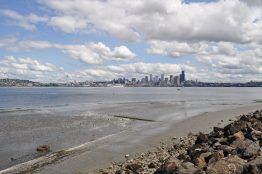Tiny aerosol particles, emitted by everything from tailpipes to trees, float above us reflecting sunlight, seeding clouds and absorbing solar heat. How exactly this happens — and how it might change in the future — is one of the biggest uncertainties in how humans are influencing climate. University of Washington scientists are part of a NASA field campaign, Observations of Aerosols Above Clouds and their Interactions, or ORACLES, that is flying research planes around clouds off the coast of Namibia to see how smoke and clouds interact.
Read more at UW Today »Microbes help plants survive in severe drought
With California in its fifth year of severe drought and many western states experiencing another year of unusually dry conditions, plants are stressed. Agricultural crops, grasses and garden plants alike can get sick and die when factors such as drought and excess sun force them to work harder to survive. Now, plants can better tolerate drought and other stressors with the help of natural microbes, University of Washington research has found.
Read more at UW Today »Remembering Sarah Reichard
UW suffered a tremendous loss this month with the passing of Professor Sarah Reichard. To other faculty members, Sarah embodied what we work so hard to become. She was a scholar who relentlessly pursued scientific understanding and – as importantly – shared what she discovered with communities so they could use new knowledge to improve our world.
Read more »Floating DNA reveals urban shorelines support more animal life
Every living thing leaves a genetic trail in its wake. As animals, plants and microbes shed cells and produce waste, they drop traces of their DNA everywhere — in the air, soil and water. Researchers are now able to capture the cells of animals, sequence their DNA and identify which species were present at a point in time. Think of it as genetic fingerprints that leave a trace of past activity.
Read more at UW Today »All polar bears across the Arctic face shorter sea ice season
It’s no secret that Arctic sea ice is melting. Polar bears, the poster child for climate change, are among the animals most affected by the seasonal and year-to-year changes in Arctic sea ice, because they rely on this surface for essential activities such as hunting, traveling and breeding. A new University of Washington study, with funding and satellite data from NASA, finds a trend toward earlier sea ice melt in the spring and later ice growth in the fall across all 19 polar bear populations, which can negatively impact the feeding and breeding capabilities of the bears.
Read more at UW Today »





